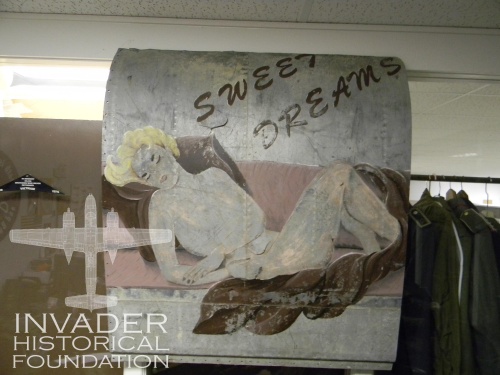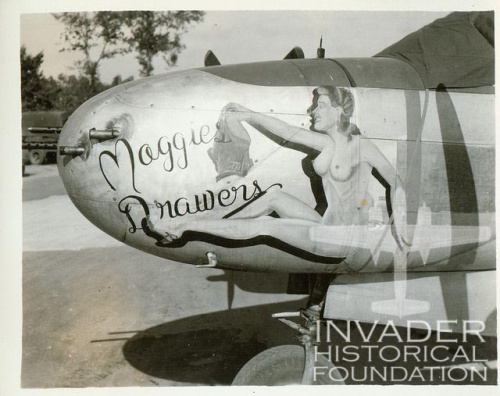Sweet Dreams Nose Art
I made a request for images to the US Militaria Forum. Shortly afterward I received a message from Mr. John Conway who wanted some help in identifying a section of nose art that he had in his collection. In his case, it wasn't a picture, but an actual section of fuselage.
According to Mr. Conway, he acquired the piece from a lady in Massachusetts. It had belonged to her father, who had recently passed away, and it was among his possessions in the barn. The lady had never seen it before and knew nothing about it.
Mr. Conway explained that he had spoken with someone several years before who thought it might have come off of an Invader. He sent me this picture of "Sweet Dreams", asking if I could help.
Upon seeing the image a few things were immediately clear. First was that this most likely was not a fake plane panel. Many people sell "nose art panels" that they allege are from bombers or fighters but are really not from any plane at all. This piece, in addition to having actual wear, bore actual rivet holes down the left side, and features a distinctive curve. Plus, the fake pieces usually have the entirety of the image captured, whereas this one is missing part of it. Based on this, it's either a very convincing fake, or its authentic. I operated on the assumption that it was authentic.
The second thing that was immediately obvious, assuming a genuine piece, was that it definitely was not from an Invader. Here is a picture of an Invader below.
On the Invader nose art is usually applied on the actual nose, which is not very big and has a high curvature. This piece is too flat. Also, the Invader has a tell-tale trapezoidal panel on the nose which this piece lacks. There are a very small number of Invaders, like Beautiful Katey, where the art is applied higher up on the fuselage. But in this cases the fuselage panels on an invader run horizontally whereas the panels on this piece run vertically, so it's not a match.
The size and shape reminded me of the angles of the Martin Marauder.
I wanted to double check and do my due diligence, so I took note of the size and shape of the panel lines on the Sweet Dreams piece.
I know that the curvature for this piece is entirely too large to be from a fighter, so that left a bomber. I checked the B-17, B-24, B-25, and B-29, but none of those matched. But I did find a plane that does match, the B-26 Marauder, as I suspected. It's not the actual nose, but if you look at the panel lines I've highlighted in red, just under the cockpit, they seem to match the piece that Mr. Conway has.
This leaves little doubt in my mind that we are looking for a Martin Marauder. So that's part of the question answered. But, I want to see if we can narrow it down to the specific plane itself.
There are 3 avenues we can use to attempt this. First, Mr. Conway is going to examine the piece for any evidence of data plates, serial numbers, or other manufacturing clues that might lead to a serial number. This would be the most direct approach, but due to the length of time that has passed I'm not convinced it will be easy to examine the manufacturers archives. The folks over at Boeing are decidedly less than helpful about answering questions.
The second approach is to examine the people involved here. Why did this man have this plane part in his barn until he died? My instinct says that this piece was sentimental to him in some way. If he didnt serve in the military himself, then maybe a close family member or personal friend did. With access to both Ancestry and Fold3 accounts, tracking this kind of information is possible. Mr. Conway is going to provide me query as much detail as he can about where, when, and from whom he got this piece and I'll take it from there.
The third method is to try to track the plane itself. Between 1941 and 1945 a total of 5,288 Marauders were built. That's a rather large haystack. But, we can narrow it down. The fact that the plane has nose art in the first place means that it definitely served in a combat unit. Training units based in the states were not permitted to paint nose art on planes. So, we can exclude any planes that were assigned to stateside units during WWII. The piece itself is in the unfinished aluminium paint scheme, so we can also eliminate any squadrons that painted their planes OD green or any other color. That still leaves a great many planes. The next idea along this line is to examine the historical photo archives of each of these silver plane units to see if there is an image of the plane.
Unlike the Invader, mist of the Marauders were scrapped and did not make it into civilian hands after the war, so the odds of this piece being something from a civilian plane are low.




